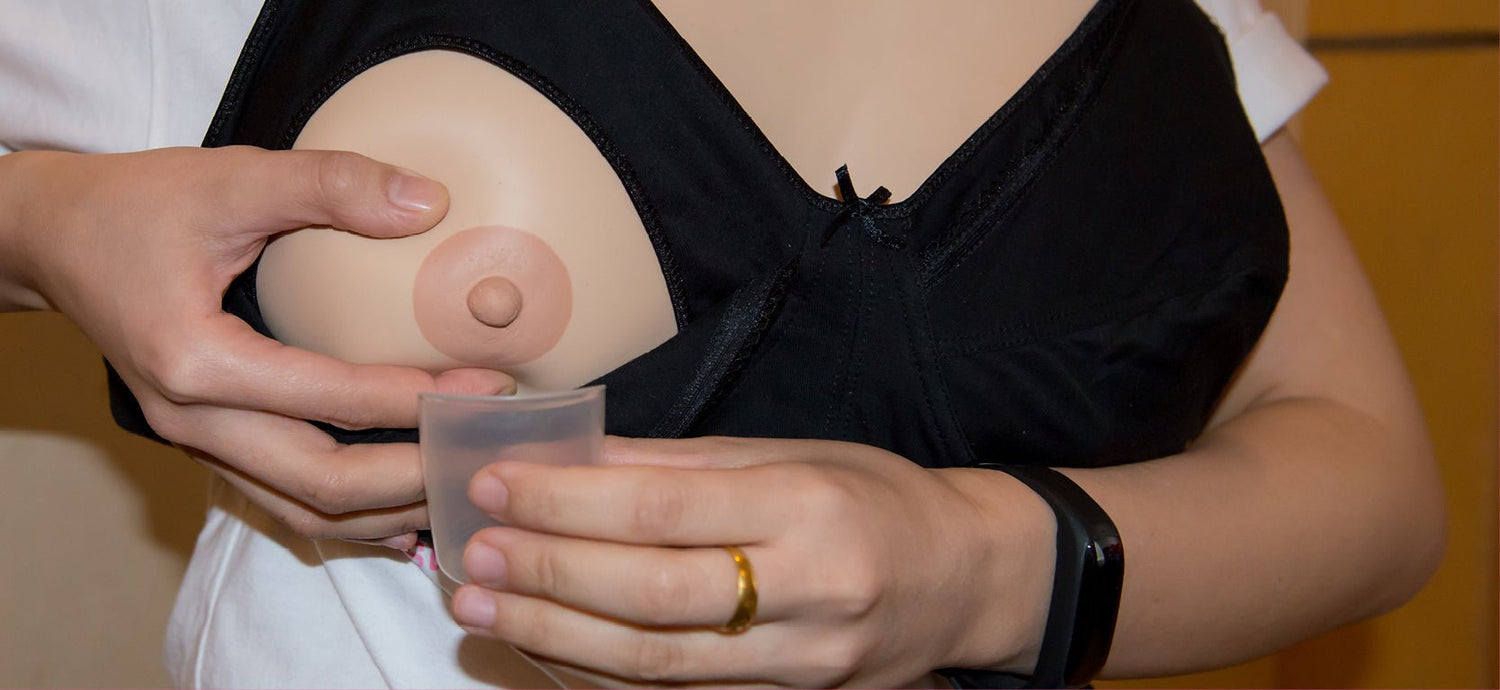WHAT IS COLOSTRUM?
If you are preparing to breastfeed, it is a great idea to learn about the process of your body producing breastmilk, starting with colostrum. Colostrum is a clear/yellow sticky looking substance that your body produces from around 20 weeks pregnant.
Colostrum is specifically made for your baby, is easily digested and is their recommended first food. Colostrum is nutrient-dense therefore your baby only needs small amounts to be satisfied. It contains many precious antibodies, proteins and sugars for your newborn in the first 4 days of life (before your milk comes in).
Your body increases colostrum production after you give birth due to hormonal changes and your baby suckling at the breast. You can express colostrum from 36 weeks pregnant, after clearance by your care provider, or postnatally after your baby is born.
WHY IS COLOSTRUM SO IMPORTANT?
There are many benefits for your little one consuming colostrum in the days following their birth. Colostrum contains amazing properties for your baby and special proteins that coat their intestinal tract to protect against harmful bacteria right from the start of life outside the womb.
Your colostrum is also full of antibodies produced from the illnesses that you have previously fought off, which are passed to your baby protecting them from those illnesses. Another great benefit of colostrum, is that it acts as a natural laxative to help bub pass their first bowel motions, which assists to prevent jaundice.
Breastmilk, including colostrum, is a living substance that contains live cells and white blood cells that help your baby fight infections, and when you or your baby are sick the amount of these cells in your breastmilk increase. These are a few of the many reasons why colostrum is referred to as liquid gold.
WHEN & WHY TO EXPRESS
There are two main occasions when expressing colostrum can be done; in the antenatal period and the postnatal period.
EXPRESSING COLOSTRUM IN THE ANTENATAL PERIOD
You will most likely hear about expressing colostrum in the antenatal period, which is often encouraged for all mama’s especially if you have diabetes. Antenatal expressing is a great way to prepare your body for breastfeeding and to collect colostrum to give to your baby after birth.
You can commence expressing from 36 weeks gestation, for 3-5 minutes per breast 2 times per day, or as recommended by your healthcare provider. You shouldn’t express before 36 weeks as nipple stimulation can cause your uterus to contract and bring on labour. If you do experience any cramps or contractions while expressing, you should stop immediately.
Also, try not to concentrate on the amount of colostrum expressed as it is not indicative of your milk supply after bub is born. The DAME (Diabetes and Antenatal Milk Expressing) study confirms this, by stating the average number of times women expressed before birth was 20 times and the average amount of colostrum expressed was a total of 5mL.
Some women were unable to express any colostrum in the study, so there is no evidence to suggest that the volume of colostrum you are able to express in the antenatal period is related to the volume of milk you will produce postnatally.
WHY SHOULD YOU EXPRESS IN THE ANTENATAL PERIOD?
Expressing colostrum can assist in the likelihood of a successful exclusive breastfeeding journey which promotes good gut bacteria for your baby. If you are planning to breastfeed, having colostrum already expressed and available to give bub after birth is super convenient and ensures bub has milk at any time.
If your baby requires more colostrum in the postnatal period and your preference is to exclusively breastfeed, having colostrum readily available will decrease the chance of your baby needing formula. The DAME study also stated, for women having their first baby there is an increased chance that their babies would be exclusively fed with breastmilk in the first 24 hours of life and until discharge from hospital if expressed colostrum was readily available.
Overall, expressing colostrum is a great skill to learn before your baby is born so you are confident with the technique and have colostrum ready in case bub needs it for any reason, such as; has difficulty attaching to the breast or you are separated.
EXPRESSING COLOSTRUM IN THE POSTNATAL PERIOD
If you didn’t express colostrum in the antenatal period or were not successful in collecting any colostrum, you can still express after your baby is born. Your midwife will be able to help you express if needed or can talk you through the technique so you are able to do it yourself.
Postnatally, you can hand express at any time. If baby is with you and breastfeeding and you are wanting to express, hand expressing after a breastfeed for around 5 minutes is ideal. If your baby is not attaching to the breast or is separated from you, expressing every 3-4 hours for 15-20 minutes is recommended, to provide bub with colostrum and increase your supply.
If bub is not with you for an extended period of time (more than 3-4 days) and you’re expressing larger amounts, your midwife may suggest using a breast pump instead of hand expressing. You can also ask to go and visit your baby if they are in special care nursery or ask your partner to take photos and videos of bub for you.
Having skin to skin with bub or looking at photos of them while you are expressing will help the release of oxytocin and assist milk production.
WHY SHOULD YOU EXPRESS IN THE POSTNATAL PERIOD?
Expressing colostrum after your baby is born may be because they are having trouble attaching to the breast, you are separated from bub or they have low blood sugar levels. Expressing extra colostrum postnatally can also be handy for night 2 & 3 when your baby is cluster feeding A LOT, meaning you can tag team with your partner and they can feed bub the colostrum so you can rest and give your nipples a break.
There is no harm in expressing colostrum postnatally to have a back-up stash in case bub is demanding extra colostrum after feeds. You can also express some colostrum to store in the freezer for future use. It can be given to bub if they are sick as it contains so many amazing antibodies to fight sickness, or used for other reasons such as an infected umbilical cord stump, eye infections/conjunctivitis and even nappy rash.
HOW TO EXPRESS COLOSTRUM
Whether you are trying to express in the antenatal or postnatal period, the technique of hand expressing is the same. If you are struggling with the technique ask your midwife to demonstrate how, or seek information from the Australian Breastfeeding Association website or reliable videos online.
The most important thing to remember when expressing is to make a rhythmic motion to imitate a baby suckling, this will help stimulate your milk ducts to produce colostrum.
Your partner can also help you with hand expressing, so you can both learn together.
- Wash your hands before expressing
- Place your thumb and forefinger 1cm away from your areola
- Press into your chest wall and then gently squeeze towards your nipple
- Create a rhythmic motion pressing in and squeezing every 1-2 seconds
- Every 30 seconds or when colostrum stops flowing, rotate the positions of your fingers around your areola
- Collect any expressed colostrum in a sterile syringe
- Store colostrum appropriately (see below)
WHAT CAN HELP WITH EXPRESSING
Hand expressing is all about practice makes perfect and feeling confident with the technique.
- Massaging your breasts for a few minutes prior to expressing is a great routine. Massage from the top of your breast downwards towards the nipple, then the underside of the breast to ensure the whole breast is massaged.
- Having skin to skin with your baby or looking at photos of them (if you are postnatal) will help that oxytocin release, as mentioned above, to help with milk production.
- Relaxation techniques such as music or slow deep breathing before and during expressing can help, as stress can prevent milk flow.
- Heat is also encouraged pre-feed to assist the release of colostrum or milk from the milk ducts. Using BodyIce Woman reusable heat packs has personally really helped me. I have used the heat packs for 5-10 minutes, at least 5 minutes before expressing.
- To help increase your milk supply you can incorporate oats, nuts, seeds, lactation biscuits (pre-made or make your own) and fenugreek tea (postnatally only) into your diet.
HOW TO STORE COLOSTRUM
Once you have expressed colostrum, it is important to store it appropriately until you need to use it. Before storing your colostrum, remember to label it with your name, date and time it was expressed. It is recommended to place colostrum at the back of the fridge or freezer (where it is the coldest) as soon as possible after expressing.
Colostrum can remain at room temperature for 4-6 hours if you are going to use it, otherwise, put it in the fridge straight away. Colostrum lasts in the fridge for 72 hours (4 degrees or lower), and freezer for 3 months. Colostrum can be stored in a deep chest freezer for 6-12 months. Once your colostrum has defrosted after being frozen, it needs to be used within 48 hours if it is in the fridge or 4 hours at room temperature.
You can combine colostrum/milk when it is at the same temperature. I personally am expressing each day into a new colostrum collector, putting them in the fridge so they become the same temperature then combining the daily colostrum for that 72 hour period - then freezing it. Always date it with the oldest colostrum.
These guidelines reference the Australian Breastfeeding Association. Please follow the guidelines of your country and be sure to check these guidelines are still current at the time of reading.
This does not replace the need for medical advice. It is always suggested to seek medical clearance prior to commencing antenatal expressing.
Our guest blog has been written by the wonderful Aliza Carr - midwife, perinatal mental health specialist and founder of online community Bumpnbub. Aliza is currently 37 weeks pregnant with her first baby 💖
Our BodyICE Woman breast packs can be used for 5-10 minutes before expressing colostrum to assist the release of colostrum or milk from the milk ducts.





Leave a comment
All comments are moderated before being published.
This site is protected by hCaptcha and the hCaptcha Privacy Policy and Terms of Service apply.